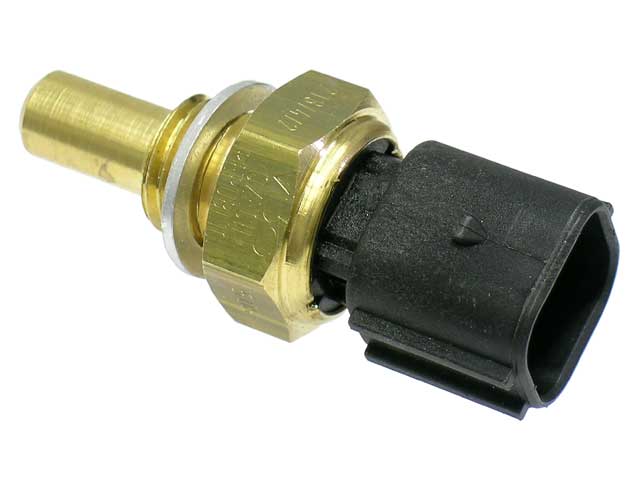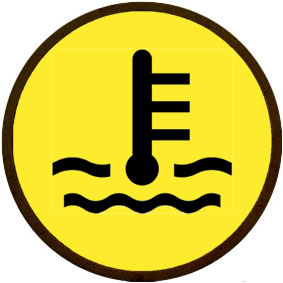A Crucial Component for Engine Performance
When it comes to the performance and overall health of your vehicle’s engine, various components play crucial roles. One such component is the engine coolant temperature sensor (ECT sensor) also known as the Water Temperature Sensor. Although often overlooked, the ECT sensor is responsible for monitoring the temperature of the engine coolant and helping regulate the engine’s operating temperature.
Table of Contents
Coolant or Water Temperature Sensor?
Unless your vehicle is on the track, you should be using a mixture of Antifreeze and Distilled Water for your engine cooling, when mixed this is called coolant so this is technically a Coolant Temperature Sensor.


Without a properly functioning ECT sensor, your vehicle’s engine could experience a range of issues, from reduced fuel efficiency to complete engine failure. In this article, we will discuss the importance of the ECT sensor, its replacement process, its location in the engine, and common faults that can occur. Whether you are a car enthusiast or simply a vehicle owner, understanding the significance of the ECT sensor and knowing how to detect and resolve any related issues can save you from costly repairs and keep your engine running smoothly. So, let’s dive in and explore the world of the engine coolant temperature sensor.
What is an Engine Coolant Temperature Sensor and How Does it Work?
An engine coolant temperature sensor is a crucial component of a vehicle’s engine management system. It monitors the temperature of the engine coolant and provides this information to the engine control unit (ECU). This sensor plays a vital role in ensuring the engine’s optimal performance by helping the ECU adjust fuel mixture, ignition timing, and other parameters based on temperature data.
The engine coolant temperature sensor is typically located near the thermostat housing or in the cylinder head. Its purpose is to accurately measure the temperature of the coolant flowing through the engine. This information is then relayed to the ECU, which uses it to determine the appropriate air-fuel mixture and ignition timing for different operating conditions.
One of the most common signs of a faulty coolant temperature sensor is the activation of the engine coolant temperature light on the dashboard. This warning light indicates that the engine is running too hot or too cold, which can lead to potential damage if not addressed promptly. Additionally, a malfunctioning sensor may cause engine performance issues such as rough idling, poor fuel efficiency, or even engine stalling.
In conclusion, the engine coolant temperature sensor is a crucial component that helps maintain the engine’s performance and prevent overheating. By monitoring the coolant temperature, it enables the ECU to make real-time adjustments to optimize fuel efficiency and performance. If you notice any warning lights or experience abnormal engine behavior, it is advisable to have the coolant temperature sensor checked for any faults by a qualified mechanic.
Importance of Maintaining and Troubleshooting Your Engine Coolant Temperature Sensor
Your engine coolant temperature sensor may not be the first thing that comes to mind when you think about car maintenance, but it plays a crucial role in keeping your engine running smoothly. This small yet powerful sensor measures the temperature of your engine coolant and sends this information to the engine control unit (ECU). The ECU then uses this data to adjust factors such as fuel mixture, idle speed, and ignition timing.
Maintaining your engine coolant temperature sensor is essential to ensure optimal engine performance and fuel efficiency. Over time, the sensor can become dirty or covered in grime, affecting its ability to accurately measure the coolant temperature. This can lead to a variety of issues, from poor engine performance and reduced fuel economy to overheating and potential engine damage. Regularly cleaning and inspecting the sensor can help identify any potential problems early on.
In some cases, however, maintaining your engine coolant temperature sensor may not be enough, and replacement may be necessary. Signs that your sensor may need replacement include inaccurate temperature readings, fluctuating temperature gauge, or warning lights on your dashboard. Engaging a professional mechanic for engine coolant temperature sensor replacement ensures that the correct procedures and tools are used to avoid any further damage to your vehicle.
Taking care of your engine coolant temperature sensor is important to keep your engine running smoothly and avoid costly repairs down the line. Regular maintenance and troubleshooting can help you catch any issues and address them before they escalate. So, the next time you’re considering car maintenance, don’t forget to give some attention to your engine coolant temperature sensor – it’s a small component that can make a big difference in your vehicle’s overall performance and longevity.
Signs of a Faulty Engine Coolant Temperature Sensor: Common Symptoms to Look Out For
The engine coolant temperature sensor is a critical component of a vehicle’s engine management system. It monitors the temperature of the engine coolant and sends the information to the engine control unit (ECU). However, just like any other sensor, it can develop faults over time. If you suspect that your engine coolant temperature sensor is faulty, here are some common symptoms to look out for.
One of the most noticeable signs of a faulty engine coolant temperature sensor is an inaccurate temperature reading on the dashboard. If you see that the temperature gauge is consistently showing unusually high or low readings, it could indicate a problem with the sensor. Additionally, if the temperature fluctuates rapidly or jumps erratically, it is another sign that the sensor may be failing.
Another symptom of a faulty engine coolant temperature sensor is poor fuel efficiency. When the sensor malfunctions, it can send incorrect signals to the ECU, leading to improper fuel delivery. This can result in either excessive fuel consumption or poor combustion, causing a decrease in fuel efficiency.
Lastly, an engine coolant temperature sensor fault can also lead to engine performance issues. If the sensor is providing inaccurate temperature readings, the ECU may not be able to adjust the fuel-to-air ratio correctly. As a result, the engine may run too rich or too lean, leading to rough idling, stalling, or poor acceleration.
If you notice any of these symptoms, it is crucial to have your vehicle inspected by a qualified mechanic. They will be able to diagnose the coolant temperature sensor fault and recommend the necessary repairs. In some cases, the sensor may need to be replaced. Remember that the engine coolant temperature sensor location can vary depending on the make and model of your vehicle, so consulting your vehicle’s manual or seeking professional help is essential for a proper replacement.
Steps to Properly Maintain Your Engine Coolant Temperature Sensor
Most of us overlook the importance of regularly maintaining our engine coolant temperature sensor. However, this small component plays a crucial role in keeping our engines running efficiently and preventing overheating. By taking the time to properly maintain your engine coolant temperature sensor, you can avoid costly repairs and ensure that your vehicle performs optimally.
The first step in maintaining your engine coolant temperature sensor is to regularly check its condition. Inspect the sensor for any signs of damage, such as cracks or corrosion. If you notice any issues, it’s important to replace the sensor immediately to prevent further damage to your engine.
Next, make sure to clean the engine coolant temperature sensor regularly. This can be done using a mild detergent and water. Gently scrub the sensor to remove any dirt or grime that may have accumulated over time. Be careful not to use any harsh chemicals or abrasive materials as these can damage the sensor.
In addition to cleaning, it’s important to test the functionality of your engine coolant temperature sensor regularly. Use a diagnostic tool to check the sensor’s readings and compare them to the manufacturer’s specifications. If you notice any inconsistencies or abnormal readings, it may be a sign that the sensor needs to be replaced.
Properly maintaining your engine coolant temperature sensor is essential for the overall health and longevity of your engine. By following these steps and being proactive in your maintenance routine, you can ensure that your sensor continues to perform effectively and keep your engine running at the optimal temperature. Don’t overlook this small yet crucial component – it can make a significant difference in your vehicle’s performance and save you from expensive repairs down the road.
How to Test and Diagnose Issues with Your Engine Coolant Temperature Sensor
If there are issues with the sensor, it can lead to a variety of problems and even engine damage. Therefore, it is essential to know how to test and diagnose any potential issues with your engine coolant temperature sensor.
The first step in testing your engine coolant temperature sensor is locating its exact position within your vehicle. Consult your vehicle’s manual or search online for the sensor’s location specific to your make and model. Once you find it, ensure the engine is completely cool before starting the diagnostic process.
To test the sensor, begin by disconnecting the electrical connector attached to it. Then, using a multimeter set to the resistance or ohms function, connect the multimeter leads to the sensor’s terminals. Compare the resistance reading to the specification provided in your vehicle’s manual. If the resistance reading is within the specified range, the sensor is functioning correctly. However, if the reading is outside the recommended range, it is likely that the engine coolant temperature sensor needs to be replaced.
In addition to testing the sensor, it is also important to inspect the wiring and connectors for any signs of damage or corrosion. Faulty wiring can also lead to inaccurate sensor readings or failure. If any issues are found with the wiring, repairs or replacements may be necessary.
In conclusion, regularly testing and diagnosing issues with your engine coolant temperature sensor is crucial for maintaining a properly functioning engine. By performing simple tests and inspections, you can identify and address any problems before they cause damage or reduce performance. Don’t overlook this essential component of your vehicle’s cooling system – keeping your engine coolant temperature sensor in good condition will ensure a smooth and efficient driving experience.
Frequently Asked Questions about the Engine Coolant Temperature Sensor
What are the symptoms of a faulty coolant temperature sensor?
If you notice that your engine temperature gauge is frequently fluctuating or reading abnormally high, it may be a sign that the sensor is malfunctioning. Additionally, if you experience issues with engine performance or strange behavior such as the engine misfiring or stalling, there’s a possibility that the sensor is faulty.
Is coolant temperature sensor easy to replace?
The exact steps may vary depending on your car’s make and model, so it’s best to consult your vehicle’s manual or seek professional assistance. Generally, the replacement process involves locating the sensor, disconnecting the electrical connectors, removing any mounting bolts, and replacing the old sensor with a new one. It’s important to handle the sensor with care and ensure it’s properly installed to avoid further complications.
How do you change a water temperature sensor?
Many car owners wonder if they can replace the engine coolant temperature sensor themselves. While it’s technically possible if you have the required tools and knowledge, it’s recommended to let a professional handle the replacement. This is because the sensor is often located in hard-to-reach areas of the engine, and mishandling it can result in further damage. Additionally, professionals have the expertise to accurately diagnose any underlying issues and ensure the sensor is replaced correctly.
